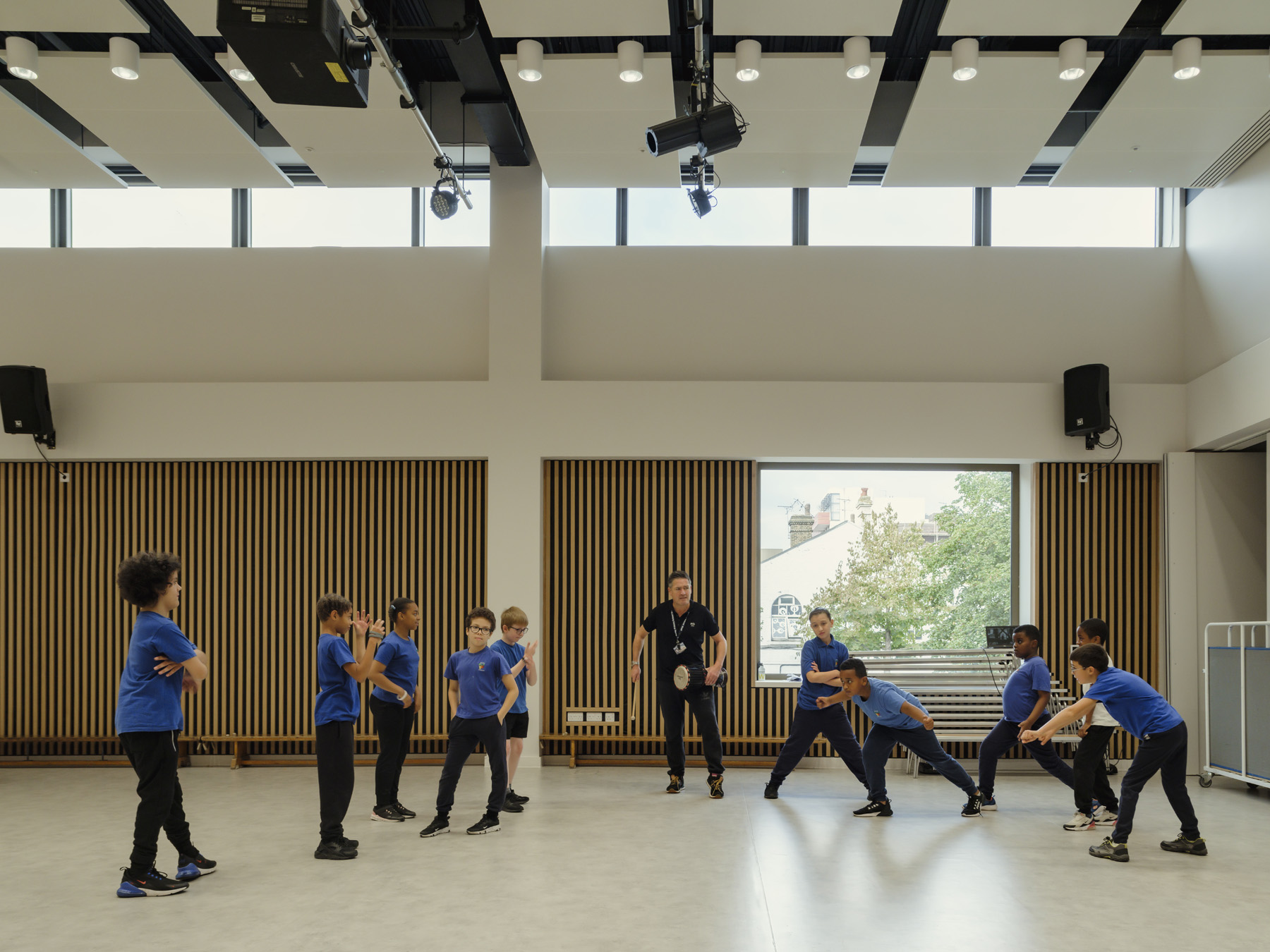Key lessons in designing schools for health and well-being
School design can play a vital role in supporting our children’s mental and physical health and well-being, an issue that was foregrounded by the Covid pandemic. From the relationship of the school within its wider community and the design of the external landscape to the design of the interior spaces, the nature of the school environment can also impact academic, social and creative performance, of both students and staff. Penoyre & Prasad has recently completed three school projects in London which, in their different ways, demonstrate how good design can aid and assist in the well-being of a school’s students, staff and the wider communities that they support.
School 360 is a new 420-pupil primary school in Sugar House Island, East London, designed specifically to support the unique curriculum of the Big Education Trust. This comprises the three pillars of head, heart and hand – developing the head to provide rich knowledge and deep understanding, the heart to focus on well-being and relationships, and the hand to encourage every child to learn about creativity, problem-solving and the arts. These informed the design and layout of the building, encouraging project-based learning in a warm and welcoming environment. Flexible classrooms allow for quick layout changes to increase student engagement levels, while moveable screens allow for multiple variations in classroom layout. Carefully positioned windows bring in plenty of daylight and allow views out to the city while avoiding overheating. Mechanical heat and ventilation is provided by an air-source heat pump connected to the site-side district heating network.
Located on a restricted urban site, the school rises over three storeys in an efficient floorplate to maximise the use of outside play space – on the roof, which includes a playground, community garden and multi-use games area, and at ground level comprising a playground and green spaces, including a ‘Forest School’ and covered outdoor classrooms. Younger year classrooms open directly onto these spaces.
Sitting at the heart of Sugar House Island, the school is rooted in the community and plays a central role in the life of the emerging mixed-use development in Stratford. The architectural treatment in brickwork – plain and ribbed – creates a civic presence and ties the building into its historic and emerging context. The facilities of the school – hall, studio, community garden – are used by local families and the wider community after hours.
New Barlby and Kensington Queensmill Schools are two co-located schools – the latter supports children with autism and learning difficulties, the former is a two-form entry primary. Combined as a single building on the site of the old Barlby School in North Kensington, the design deftly negotiates a complex site to create separate playgrounds, entrances and identities for each school while offering the benefit of shared services.
Despite the restricted urban site, nature and play are introduced throughout the school. The mature existing trees have been retained, and planting and a honeycomb geometry pattern is a recurring theme. Classrooms have large generous windows to maximise daylight and bring the sense of nature inside, while extensive of use of timber extends the sense of nature throughout the interior. External play is maximised at all levels, from the multiple supervised ground level play spaces to the five roof terraces that step up the building, each with a different character. Nursery and reception classes have their own external play areas.
Flexibility is ensured through the three reconfigurable halls that can be opened up in various combinations to host a range of activities of the school and community. The Primary School shares facilities with the adjacent Treverton Estate, while the school invites the community in to use its own community room, halls, library, art room and MUGA.
The schools are part of a mixed-use development for the area that sees the regeneration of the wider area. A key aspiration was for the school to reflect the Borough’s pride in education and create a sense of place. This is done through the high-quality design, maximising opportunities for enriched learning and play for the children and the wider community, and a carefully crafted architecture that sits harmoniously in its neighbourhood, itself a Conservation Area.
Grenfell Nursery is a cornerstone of the Lancaster West Children’s Community Network which provides care, support and nursery facilities for young children, their carers and their families within the estate. The nursery, occupying temporary accommodation for four years following the Grenfell Tragedy, now has a new permanent home that will support and celebrate their vital work.
Shoehorned into a sliver of space between two of the existing housing blocks, the design bursts out of its confines, transforming a once cluttered and dark space into a place of light and openness, colour and joy. A palette of natural materials and muted colours provides a calm and welcoming environment for the children, while large windows and roof lights bring daylight deep into the plan. At both levels, the playrooms are connected to the outside, maximising opportunities for play both inside and out.
Outside play is fundamental to the children’s learning and development and the landscape design works hard to provide a stimulating and playful environment, creating possibilities for children to interpret and explore. The design enhances ecology and biodiversity through the introduction of green roofs, meadow planting, green walls and a wide range of different planting that changes through the seasons. Large areas of runaround space allows for free play activities and exercise. A green-roofed adapted shipping container forms an external classroom around the year.
These three schools demonstrate how good design can support both our children’s learning, their health and well-being and the needs of the wider community. As we move forward in refurbishing, retrofitting and building new schools in these straitened times, these issues will become ever more pertinent.

The compact form and materiality of School 360 creates a civic presence on Sugar Island. The careful massing maximises the use of the site for external play, both at ground level and on the roof.

Outdoor classroom on the roof of School 360

New Barlby and Kensington Queensmill co-located school is carefully organised on a tight urban site to maximise the use of various types of external playspace and retain all the existing mature trees.

The hall and dining space at New Barlby and Kensington Queensmill school is a flexible and adaptable shared space for both schools and the wider community. Natural materials, plenty of daylight and views out onto greenery create a calm and nurturing environment.
Find out more about Penoyre and Prasad and the Architect Design Services (ADS1.1) framework they are on.


